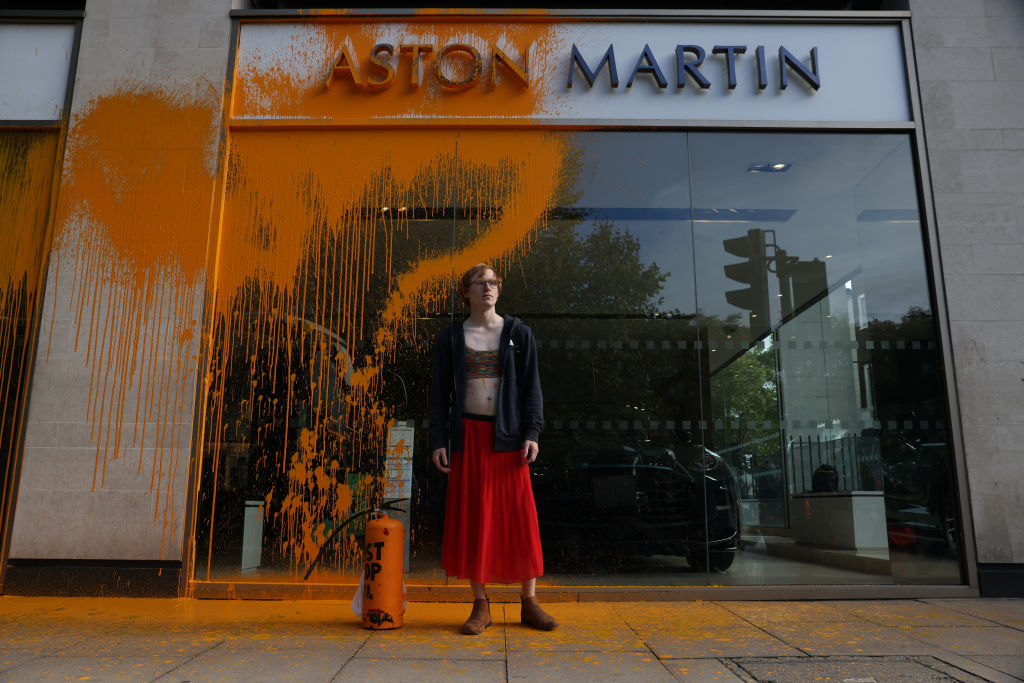European climate protesters have taken up a new tactic in the fight to curb global emissions: throwing food at famous paintings.
The trend started earlier this month, when a pair of activists with climate group Just Stop Oil walked into the U.K.’s National Gallery on Oct. 14 and hurled tomato soup at Sunflowers, an iconic painting by Vincent Van Gogh, before gluing their hands to the wall beneath the painting. Then, on Oct. 23, protesters affiliated with the German group Letzte Generation (Last Generation) threw mashed potatoes on Grainstacks by Claude Monet at the Barberini Museum in Potsdam, Germany, before also sticking their hands to the wall. The stunts didn’t damage the paintings, which were protected by a pane of glass.
These protests have certainly achieved the goal of catching the world’s attention, but for some used to seeing climate activists hold placards in the streets, these creative stunts may be a bit confounding: why throw food at art in the name of the climate crisis? For protesters, the point is partially to get attention, and also to illustrate the degree of complacency among the general public. “What is worth more, art or life?” one of the activists shouted at the National Gallery in London. “Are you more concerned about the protection of a painting or the protection of our planet?”
Where did these protests come from?
This month’s events aren’t isolated incidents—climate protesters in the U.K., Germany, and Italy have been gluing themselves to celebrated artworks like Sandro Botticelli’s Primavera, and Thunderscape With Pyramus and Thisbe by Nicolas Poussin this summer, though the stunts hadn’t previously involved throwing food.

The art stunts come as perhaps the most eye-catching portions of larger campaigns. In the U.K. protesters with Just Stop Oil have been blocking roads around London as part of a daily barrage of “civil resistance” over the past month, which the group claims has resulted in 576 arrests. They’ve spray-painted the facade of the famous Harrods department store and an Aston Martin showroom, and, on Oct. 17, scaled support cables on the Queen Elizabeth II Bridge outside the city, forcing police to shut down traffic over the Thames River. And this week in London, activists affiliated with the group smeared chocolate cake on a wax sculpture of King Charles III at Madame Tussauds, and splashed paint on the headquarters of a U.K. fossil fuels lobbying group.
Protesters in Germany with Letzte Generation have used similar tactics, blocking roadways, and this June spraying the chancellery in Berlin with a black substance that looked like oil.
What’s the goal of these protests?
The groups have framed their efforts as campaigns of nonviolent civil disobedience, intended to draw people’s attention to the climate crisis, and what activists say are their government’s woefully inadequate efforts to cut emissions.
But the more specific goals of the protests differ. In Germany, the stunts have centered on demands to cut speed limits on the country’s highways to 100 kilometers per hour (62 miles per hour) and to make public transit more affordable. Increasing use of public transportation and lowering speed limits for passenger vehicles would decrease vehicle emissions and cut fuel consumption.

In the U.K., where former Prime Minister Liz Truss decimated much of the nation’s climate progress during her short tenure, the climate protesters’ messaging has revolved around spiking energy costs due to the war in Ukraine driving up fossil fuel prices, and the British government’s move to allow oil and gas companies access to new drilling locations in the North Sea, which it claims would improve the country’s energy security. (Although the new fossil fuel exploration will not lower U.K. energy prices in the short term.)
“The cost of living crisis is part of the cost of oil crisis,” Phoebe Plummer yelled in the National Gallery after throwing soup on the Van Gogh painting. “Fuel is unaffordable to millions of cold, hungry families. They can’t even afford to heat a tin of soup.”
Have these protests been successful?
While shutting down roadways certainly gets the attention of local commuters and civil authorities, the recent art stunts—both of which were filmed and posted on social media—are also clearly aimed at an international audience, with the purpose of shocking people out of complacency as emissions rise and the window to avert catastrophic temperature increases grows smaller. “We are in a climate catastrophe and all you are afraid of is tomato soup or mashed potatoes on a painting,” shouted Mirjam Herrmann, 25, speaking in German, after splattering the Monet. “When will you finally listen and stop business as usual?”
They certainly have sparked conversations. British Foreign Secretary James Cleverly wrote online that people should “stop giving these attention seeking adult-toddlers the coverage they clearly crave.” Irish musician Bob Geldof, meanwhile, said the activists who threw soup on the Van Gogh painting were “1000% right.” “They’re not killing anyone,” he told the U.K.’s Radio Times. “Climate change will.”
For the activists, that attention is what matters. “I recognize that it looks like a slightly ridiculous action,” Plummer said in an interview the day after she appeared in court for her actions. “I agree; it is ridiculous. But we’re not asking the question if everyone should be throwing soup on paintings. What we’re doing is getting the conversation going so we can ask the questions that matter.”
More Must-Reads from TIME
- Inside Elon Musk’s War on Washington
- Meet the 2025 Women of the Year
- The Harsh Truth About Disability Inclusion
- Why Do More Young Adults Have Cancer?
- Colman Domingo Leads With Radical Love
- How to Get Better at Doing Things Alone
- Cecily Strong on Goober the Clown
- Column: The Rise of America’s Broligarchy
Write to Alejandro de la Garza at alejandro.delagarza@time.com